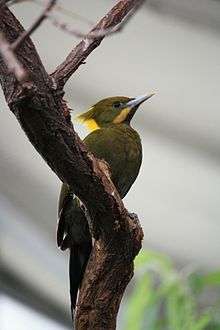Chrysophlegma
Chrysophlegma is a genus birds in the woodpeckers family Picidae. These species, found in South and Southeast Asia were all previously assigned to the genus Picus.
| Chrysophlegma | |
|---|---|
| Scientific classification | |
| Kingdom: | Animalia |
| Phylum: | Chordata |
| Class: | Aves |
| Order: | Piciformes |
| Family: | Picidae |
| Tribe: | Picini |
| Genus: | Chrysophlegma Gould, 1850 |
| Species | |
|
See text | |
Taxonomy
The species now placed in Chrysophlegma were previously assigned to the genus Picus. A molecular phylogenetic study published in 2008 found that the genus Picus, as then defined, formed two separate clades and might not be monophyletic. Three species were therefore moved from Picus into the resurrected genus Chrysophlegma,[1][2] which had been introduced in 1850 by the English ornithologist John Gould to accommodate the greater yellownape (Chrysophlegma flavinucha).[3] The genus name combines the Classical Greek khrusos meaning "gold" and phlegma meaning "flame" or "fire".[4]
The genus contains 3 species.[2]
| Image | Scientific name | Common Name | Distribution |
|---|---|---|---|
 | Chrysophlegma flavinucha[5] | Greater yellownape | East Asia from northern and eastern India to south-eastern China, Indochina, Hainan, and Sumatra |
.jpg) | Chrysophlegma mentale[6] | Checker-throated woodpecker | Myanmar, Thailand, Malaysia, Singapore, Brunei, and Indonesia. |
_female_-_Flickr_-_Lip_Kee.jpg) | Chrysophlegma miniaceum[7] | Banded woodpecker | Brunei, Indonesia, Malaysia, Myanmar, Singapore, and Thailand |
References
- Fuchs, J.; Pons, J.-M.; Ericson, P.G.P.; Bonillo, C.; Couloux, A.; Pasquet, E. (2008). "Molecular support for a rapid cladogenesis of the woodpecker clade Malarpicini, with further insights into the genus Picus (Piciformes: Picinae)". Molecular Phylogenetics and Evolution. 48 (1): 34–46. doi:10.1016/j.ympev.2008.03.036.
- Gill, Frank; Donsker, David; Rasmussen, Pamela, eds. (2020). "Woodpeckers". IOC World Bird List Version 10.1. International Ornithologists' Union. Retrieved 17 May 2020.
- Gould, John (1850). "Chrysophlegma flavinucha". The Birds of Asia. Volume 6. London: self. Plate 36 and text.
- Jobling, James A. (2010). The Helm Dictionary of Scientific Bird Names. London: Christopher Helm. p. 105. ISBN 978-1-4081-2501-4.
- "Chrysophlegma flavinucha". IUCN Red List of Threatened Species. Retrieved 2014-12-30.
- "Chrysophlegma humii". IUCN Red List of Threatened Species. Retrieved 2014-12-30.
- "Chrysophlegma miniaceum". IUCN Red List of Threatened Species. Retrieved 2014-12-30.